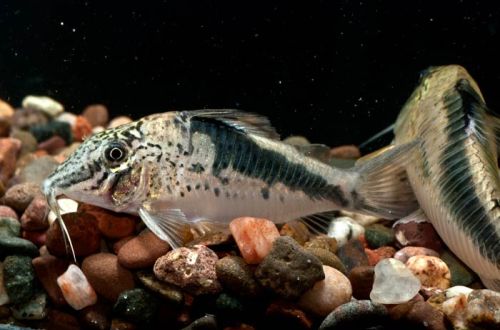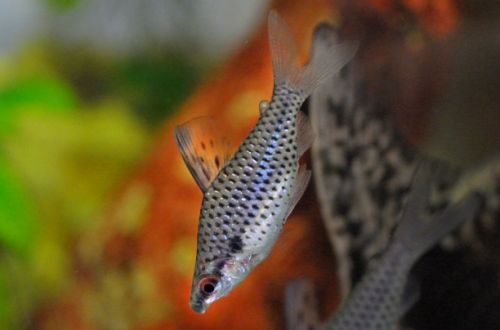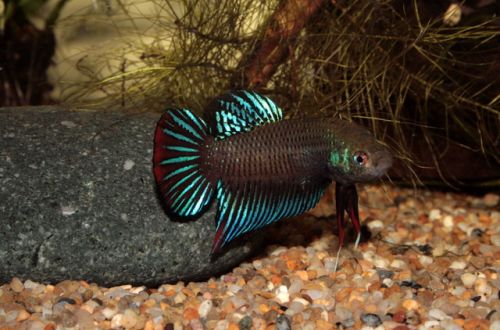
Erromizon Chinese
Erromyzon sinensis or Chinese Erromyzon, scientific name Erromyzon sinensis, belongs to the family Balitoridae (river loaches). Rarely seen in hobby aquariums outside of Asia. The content comes with a number of challenges, which, coupled with the unremarkable coloring, makes it a desirable acquisition by only a small number of enthusiasts.

Contents
Habitat
Comes from southern China. It is found in the upper and middle basins of the Pearl River, also known as the Pearl River – the third longest in the country. The natural habitat is limited to the provinces of Guangxi and Guangdong. Inhabits sections of rivers and their tributaries flowing through hilly terrain, characterized by fast, turbulent water and numerous cascades and rapids. Aquatic vegetation grows mainly along the coastline. The bottom consists of rocky and sandy substrates interspersed with large boulders and rock fragments.
Brief information:
- The volume of the aquarium – from 60 liters.
- Temperature – 18-24°C
- Value pH — 6.0–7.5
- Water hardness – soft (1-10 dGH)
- Substrate type — stony
- Lighting – moderate or bright
- Brackish water – no
- Water movement – moderate or strong
- The size of the fish is about 4 cm.
- Nutrition – plant-based sinking gel foods
- Temperament – peaceful
- Content alone or in a group
Description
Adult individuals reach a length of about 4 cm. The body is elongated, slightly flattened. Paired fins are oriented horizontally and are located closer to the bottom, helping the fish to hold securely on the surface, for example, stones and resist strong currents. The coloration is dark with a pattern of irregular light lines and specks. Sexual dimorphism is weakly expressed, it is problematic to distinguish between male and female.
Food
In nature, they feed on the so-called biofilm formed on stones and consisting of a layer of algae and small invertebrates inhabiting them. In a home aquarium, food should also include vegetable and protein components. Since the fish lives with a fairly strong movement of water, most of the food supplied will be carried throughout the aquarium. A good choice would be specialized gel-like feeds that look like a thick paste that can be applied directly to the ground.
Maintenance and care, arrangement of the aquarium
The optimal size of the aquarium for 3-4 fish starts from 60-70 liters. When keeping Erromizon Chinese, it is important to provide clean running water rich in oxygen and the presence of an internal current. This can be handled by a productive internal filter combined with an aeration system. It is desirable that the water turnover be 10-15 per hour, i.e. in a 60-liter tank, the filter should pump 600 liters every hour. To maintain biological balance, one cannot rely only on the operation of the filter; it will also require a weekly replacement of part of the water (30–50% of the volume) with fresh and timely removal of accumulated organic waste (uneaten food residues, excrement).
The decor is simple. Given the presence of a strong current, light and loose decor cannot be used, many living plants are excluded. It is quite enough to pour a layer of stones, boulders on the bottom and place several large snags. In bright light, the wood surface will become a place for the active growth of algae – an additional source of food for fish.
Behavior and Compatibility
Erromizon sinensis is considered a territorial species, but at the same time it is quite capable of getting along with congeners if food sources are placed in different places and the fish do not have to compete with each other for food.
Peacefully tuned in relation to other aquarium fish. However, due to the specific habitat, picking up neighbors will not be easy. For example, some gastromisons and other non-aggressive loaches will do.
Breeding / breeding
At the time of writing, the authors managed to find only one documented case of successful breeding of this species in a home aquarium. Aquarist Gerhard Otto from Germany was able to get fry from one pair three times, but it was not possible to grow them to adulthood. According to him, the fish do not show parental care. Immediately after spawning, the eggs are left to themselves. Once at the bottom, they roll into the spaces between the stones. The fry that have appeared also spend the first days of life in shelters, emerging from them at night.
Fish diseases
Health problems arise only in case of injuries or when kept in unsuitable conditions, which depresses the immune system and, as a result, provokes the occurrence of any disease. In the event of the appearance of the first symptoms, first of all, it is necessary to check the water for the excess of certain indicators or the presence of dangerous concentrations of toxic substances (nitrites, nitrates, ammonium, etc.). If deviations are found, bring all values back to normal and only then proceed with treatment. Read more about symptoms and treatments in the Aquarium Fish Diseases section.





